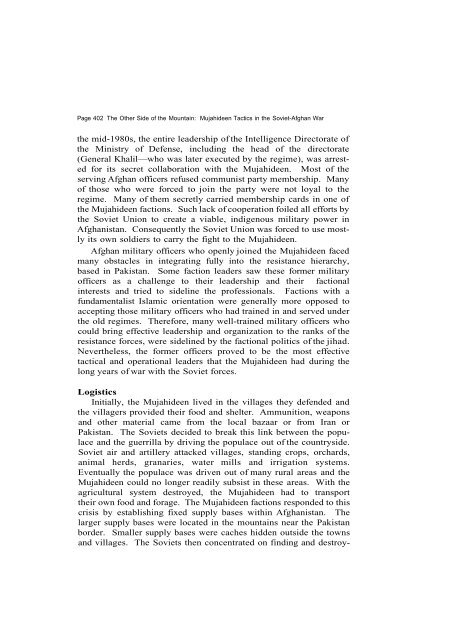Mujahideen Tactics in the Soviet-Afghan War - Bennett Park Raiders
Mujahideen Tactics in the Soviet-Afghan War - Bennett Park Raiders
Mujahideen Tactics in the Soviet-Afghan War - Bennett Park Raiders
You also want an ePaper? Increase the reach of your titles
YUMPU automatically turns print PDFs into web optimized ePapers that Google loves.
Page 402 The O<strong>the</strong>r Side of <strong>the</strong> Mounta<strong>in</strong>: <strong>Mujahideen</strong> <strong>Tactics</strong> <strong>in</strong> <strong>the</strong> <strong>Soviet</strong>-<strong>Afghan</strong> <strong>War</strong><br />
<strong>the</strong> mid-1980s, <strong>the</strong> entire leadership of <strong>the</strong> Intelligence Directorate of<br />
<strong>the</strong> M<strong>in</strong>istry of Defense, <strong>in</strong>clud<strong>in</strong>g <strong>the</strong> head of <strong>the</strong> directorate<br />
(General Khalil—who was later executed by <strong>the</strong> regime), was arrested<br />
for its secret collaboration with <strong>the</strong> <strong>Mujahideen</strong>. Most of <strong>the</strong><br />
serv<strong>in</strong>g <strong>Afghan</strong> officers refused communist party membership. Many<br />
of those who were forced to jo<strong>in</strong> <strong>the</strong> party were not loyal to <strong>the</strong><br />
regime. Many of <strong>the</strong>m secretly carried membership cards <strong>in</strong> one of<br />
<strong>the</strong> <strong>Mujahideen</strong> factions. Such lack of cooperation foiled all efforts by<br />
<strong>the</strong> <strong>Soviet</strong> Union to create a viable, <strong>in</strong>digenous military power <strong>in</strong><br />
<strong>Afghan</strong>istan. Consequently <strong>the</strong> <strong>Soviet</strong> Union was forced to use mostly<br />
its own soldiers to carry <strong>the</strong> fight to <strong>the</strong> <strong>Mujahideen</strong>.<br />
<strong>Afghan</strong> military officers who openly jo<strong>in</strong>ed <strong>the</strong> <strong>Mujahideen</strong> faced<br />
many obstacles <strong>in</strong> <strong>in</strong>tegrat<strong>in</strong>g fully <strong>in</strong>to <strong>the</strong> resistance hierarchy,<br />
based <strong>in</strong> Pakistan. Some faction leaders saw <strong>the</strong>se former military<br />
officers as a challenge to <strong>the</strong>ir leadership and <strong>the</strong>ir factional<br />
<strong>in</strong>terests and tried to sidel<strong>in</strong>e <strong>the</strong> professionals. Factions with a<br />
fundamentalist Islamic orientation were generally more opposed to<br />
accept<strong>in</strong>g those military officers who had tra<strong>in</strong>ed <strong>in</strong> and served under<br />
<strong>the</strong> old regimes. Therefore, many well-tra<strong>in</strong>ed military officers who<br />
could br<strong>in</strong>g effective leadership and organization to <strong>the</strong> ranks of <strong>the</strong><br />
resistance forces, were sidel<strong>in</strong>ed by <strong>the</strong> factional politics of <strong>the</strong> jihad.<br />
Never<strong>the</strong>less, <strong>the</strong> former officers proved to be <strong>the</strong> most effective<br />
tactical and operational leaders that <strong>the</strong> <strong>Mujahideen</strong> had dur<strong>in</strong>g <strong>the</strong><br />
long years of war with <strong>the</strong> <strong>Soviet</strong> forces.<br />
Logistics<br />
Initially, <strong>the</strong> <strong>Mujahideen</strong> lived <strong>in</strong> <strong>the</strong> villages <strong>the</strong>y defended and<br />
<strong>the</strong> villagers provided <strong>the</strong>ir food and shelter. Ammunition, weapons<br />
and o<strong>the</strong>r material came from <strong>the</strong> local bazaar or from Iran or<br />
Pakistan. The <strong>Soviet</strong>s decided to break this l<strong>in</strong>k between <strong>the</strong> populace<br />
and <strong>the</strong> guerrilla by driv<strong>in</strong>g <strong>the</strong> populace out of <strong>the</strong> countryside.<br />
<strong>Soviet</strong> air and artillery attacked villages, stand<strong>in</strong>g crops, orchards,<br />
animal herds, granaries, water mills and irrigation systems.<br />
Eventually <strong>the</strong> populace was driven out of many rural areas and <strong>the</strong><br />
<strong>Mujahideen</strong> could no longer readily subsist <strong>in</strong> <strong>the</strong>se areas. With <strong>the</strong><br />
agricultural system destroyed, <strong>the</strong> <strong>Mujahideen</strong> had to transport<br />
<strong>the</strong>ir own food and forage. The <strong>Mujahideen</strong> factions responded to this<br />
crisis by establish<strong>in</strong>g fixed supply bases with<strong>in</strong> <strong>Afghan</strong>istan. The<br />
larger supply bases were located <strong>in</strong> <strong>the</strong> mounta<strong>in</strong>s near <strong>the</strong> Pakistan<br />
border. Smaller supply bases were caches hidden outside <strong>the</strong> towns<br />
and villages. The <strong>Soviet</strong>s <strong>the</strong>n concentrated on f<strong>in</strong>d<strong>in</strong>g and destroy-




